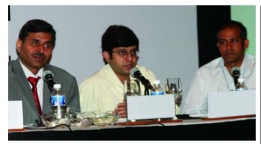
P.K. Shah
Deputy GM, Broadband Services, BSNL
Implementation of IPTV by BSNL
Like everywhere else in the world, the home entertainment space in India offers a plethora of opportunities, exceeding even those offered by telephony and computing.According to a Confederation of Indian Industry-KPMG report, India has over 119 million TV households and is adding over 7-8 million users every year, as compared to 39 million fixed line connections (with less than zero annual additions) and 30 million PCs (with 7 million annual additions).
According to industry estimates, the cable and satellite TV market is expected to penetrate 115 million households by 2013 from the current 68 million, at a compounded annual growth rate (CAGR) of 11 per cent. Internet protocol TV (IPTV) is expected to garner a reasonable share of this market.
Customers and telcos both stand to gain from IPTV. For customers, the value additions offered by IPTV include:
Looking to tap this potential, Bharat Sanchar Nigam Limited (BSNL) aims to garner more than 4 million IPTV subscribers by 2013. The incumbent launched IPTV services in early 2008 in 25 cities. The services were introduced in 10 more cities in October 2008. By March 31, 2010, the telecom operator hopes to offer IPTV in 200 cities.
The model adopted by BSNL for IPTV delivery is a complex and dynamic system, comprising a variety of elements and players in the value chain. In order to provide these services, BSNL focuses on its core competence.
However, the uptake of IPTV has been slow so far. There are hurdles in the key areas of technology, QoS, network, regulation and content.
With regard to technology, BSNL is faced with the following issues:
The following issues remain with regard to QoS:
On the network side, the challenges can be on account of the video head-end, the transport layer 3 network, aggregation and last mile access site, and customer premises.
Challenges on the video head-end include the following:
On the transport layer 3 network, the following complications can arise:
With regard to aggregation and last mile (metro Ethernet network) layer 2 network, the issues are:
On the regulation side, the concerns are as follows:
On the content side, the main hurdle is the reluctance of media houses and content providers to share content.
However, issues and concerns notwithstanding, BSNL has identified several key areas that will facilitate the growth of the technology in the future.These are introduction of Wi-Max and fibre to the home. Along with this, the incumbent's substantial copper backbone will expectedly push the growth of broadband to 5 million per year.
Going forward, BSNL plans to offer services like video surveillance, voice over IP (VOIP), and video and audio conferencing on the IPTV platform. It thus hopes to provide interactive and personalised entertainment and communication to its customers.
B.K. Badola
General Manager, IT, MTNL
MTNL's IPTV perspective
MTNL initially trialled IPTV services in October 2006. It introduced tariff plans for the service only in August 2008.
The operator has identified several key drivers for IPTV in the country:
MTNL has adopted a franchisee model to deliver IPTV services to its customers. Currently, the operator has two franchisees and the service delivery model is based on revenue sharing, in which revenue from advertising forms a part of the sharable revenue.
The technologies used for delivering IPTV include ADSL2+, VDSL and metro Ethernet. The services that are currently being offered include multicast, VoD, time shift TV, passive optic network (in the pipeline), 3G for mobile (under implementation), and mobile TV (on GPRS).
The experience so far has thrown up the following challenges:
Nevertheless, the IPTV service provides a strong value proposition for all segments – consumers, content owners and distributors, advertisers and service providers. Going forward, MTNL will provide services such as TV gaming, high definition TV and mobile TV (using the 3G mobile network).
Sal Arora
General Manager, India, Connected TV Business Group, Microsoft Corporation
TV via telcos
The requirements of consumers can, to some degree, be predicted by discussing the benefits of IPTV and observing the paradigm shift in the way customers consume content such as ringtones, callback tones, pictures, and recommendations for consumer goods and services.
A few trends that have emerged in the market show how connected applications such as VOIP or messaging are changing the way people communicate. The personalisation of media on mobiles has facilitated the growth of the mobile industry.
Within all these shifts, however, TV has remained an isolated device. Things are still regimented by TV schedules and the notion of prime time. IPTV, therefore, acts as a bridge between the TV and the consumer. TV becomes connected to diverse content (such as HBO, YouTube, personal media, etc.), diverse devices (laptops, PCs, etc.) as well as diverse networks (VDSL, ADSL, 3G, metro Ethernet, etc.)
The success of IPTV will hinge on the following factors:
Globally, the uptake of IPTV has been considerable. In a 2008 residential TV service satisfaction study, AT&T's U-verse was ranked highest in terms of overall satisfaction, performance and reliability, customer service, cost of service, billing and offerings and promotions. The company was followed by Verizon and DIRECTV. It remains to be seen whether IPTV can replicate its success abroad in India.
All in all, IPTV will cater to the changing requirements of consumers by offering a host of new and innovative services.